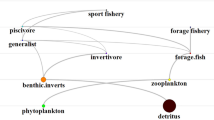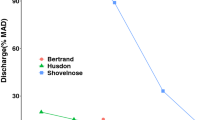Abstract
Drift-foraging models offer a mechanistic description of how fish feed in flowing water and the application of drift-foraging bioenergetics models to answer both applied and theoretical questions in aquatic ecology is growing. These models typically include nonlinear descriptions of ecological processes and as a result may be sensitive to how model inputs are summarized because of a mathematical property of nonlinear equations known as Jensen’s inequality. In particular, we show that the way in which continuous size distributions of invertebrate prey are represented within foraging models can lead to biases within the modeling process. We begin by illustrating how different equations common to drift-foraging models are sensitive to invertebrate inputs. We then use two case studies to show how different representations of invertebrate prey can influence predictions of energy intake and lifetime growth. Greater emphasis should be placed on accurate characterizations of invertebrate drift, acknowledging that inferences from drift-foraging models may be influenced by how invertebrate prey are represented.



Similar content being viewed by others
References
Benke AC, Huryn AD, Smock LA, Wallace JB (1999) Length-mass relationships for freshwater macroinvertebrates in North America with particular reference to the southeastern United States. J N Am Benthol Soc 18(3):308–343
Brett JR, Glass NR (1973) Metabolic rates and critical swimming speeds of sockeye salmon (Oncorhynchus nerka) in relation to size and temperature. J Fish Res Board Can 30(3):379–387
Cummins KW, Wuychek JC (1971) Caloric equivalents for investigations in ecological energetics. Internationale Vereinigung fur Theoretische und Angewandte Limnologie, no 18. E. Schweizerbart science publishers, Stuttgart, Germany, p 1–158
Dodrill MJ, Yackulic CB, Kennedy TA, Hayes JW (2016) Prey size and availability limits the maximum size of rainbow trout in the Glen canyon dam tailwater: insights from a drift-foraging bioenergetics model. Can J Fish Aquat Sci 73(5):759–772
Duursma RA, Robinson AP (2003) Bias in the tree model as a consequence of Jensen's inequality. Forest Ecol Manag 186(1–3):373–380
Hafs AW, Harrison LR, Utz RM, Dunne T (2014) Quantifying the role of woody debris in providing bioenergetically favorable habitat for juvenile salmon. Ecol Model 285:30–38
Hayes JW, Hughes NF, Kelly LH (2007) Process-based modelling of invertebrate drift transport, net energy intake and reach carrying capacity for drift-feeding salmonids. Ecol Model 207(2–4):171–188
Hayes JW, Jowett IG (1994) Microhabitat models of large drift-feeding brown trout in three New Zealand rivers. N Am J Fish Manag 14(4):710–725
Hayes JW, Stark JD, Shearer KA (2000) Development and test of a whole-lifetime foraging and bioenergetics model for drift feeding brown trout. Trans Am Fish Soc 129(2):315–332
Holling CS (1959) The components of predation as revealed by a study of small-mammal predation of the European pine sawfly. Can Entomol 91(5):293–320
Hughes NF, Dill LM (1990) Position choice by drift-feeding salmonids--model and test for arctic grayling (Thymallus arcticus) in subarctic mountain streams, interior Alaska. Can J Fish Aquat Sci 47(10):2039–2048
Hughes NF, Hayes JW, Shearer KA, Young RG (2003) Testing a model of drift-feeding using three-dimensional videography of wild brown trout, Salmo trutta, in a New Zealand river. Can J Fish Aquat Sci 60(12):1462–1476
Jensen JLWV (1906) Sur les fonctions convexes et les inégalités entre les valeurs moyennes. Acta Mathematica 30(1):175–193
Kennedy TA, Yackulic CB, Cross WF, Grams PE, Yard MD, Copp AJ (2014) The relation between invertebrate drift and two primary controls, discharge and benthic densities, in a large regulated river. Freshw Biol 59(3):557–572
Neuswanger J, Wipfli MS, Rosenberger AE, Hughes NF (2014) Mechanisms of drift-feeding behavior in juvenile Chinook salmon and the role of inedible debris in a clear-water Alaskan stream. Environ Biol Fish 97(5):489–503
Okuyama T (2008) Individual behavioral variation in predator–prey models. Ecol Res 23(4):665–671
Piccolo JJ, Frank BM, Hayes JW (2014) Food and space revisited--the role of drift-feeding theory in predicting the distribution, growth, and abundance of stream salmonids. Environ Biol Fish 97(5):475–488
Piccolo JJ, Hughes NF, Bryant MD (2008) Water velocity influences prey detection and capture by drift-feeding juvenile coho salmon (Oncorhynchus kisutch) and steelhead (Oncorhynchus mykiss irideus). Can J Fish Aquat Sci 65(2):266–275
R Core Team (2014). R: A language and environment for statistical computing. R Foundation for Statistical Computing, Vienna, Austria. URL http://www.R-project.org/.
Railsback SF, Harvey BC, Jackson SK, Lamberson RH (2009) InSTREAM – The individual-based stream trout research and environmental assessment model. Department of Agriculture, Forest Service, Pacific Southwest Research Station, Albany, Calif., p 254
Rosenfeld JS, Bouwes N, Wall CE, Naman SM (2014) Successes, failures, and opportunities in the practical application of drift-foraging methods. Environ Biol Fish 97(5):551–574
Rosenfeld JS, Taylor J (2009) Prey abundance, channel structure and the allometry of growth rate potential for juvenile trout. Fish Manag Ecol 16(3):202–218
Ruel JJ, Ayers MP (1999) Jensen's inequality predicts effects of environmental variation. Trends Ecol Evol 14(9):361–366
Stewart DJ (1980) Salmonid predators and their forage base in Lake Michigan – A bioenergetics-modeling synthesis. University of Wisconsin
Urabe H, Nakajima M, Torao M, Aoyama T (2010) Evaluation of habitat quality for stream salmonids based on a bioenergetics model. Trans Am Fish Soc 139(6):1665–1676
Urabe H, Nakajima M, Torao M, Aoyama T (2014) Application of a bioenergetics model to estimate the influence of habitat degradation by check dams and potential recovery of masu salmon populations. Environ Biol Fish 97(5):587–598
Utz RM, Zeug SC, Cardinal BJ (2012) Juvenile Chinook salmon, Oncorhynchus tshawytscha, growth and diet in riverine habitat engineered to improve conditions for spawning. Fish Manag Ecol 19(5):375–388
Wall CE, Bouwes N, Wheaton JM, Saunders WC, Bennett, SN. (2016) Net rate of energy intake predicts reach-level steelhead (Oncorhynchus mykiss) densities in diverse basins from a large monitoring program. Can J Fish Aquat Sci In Press
Acknowledgments
We extend thanks to John Hayes, Andrew Hafs, Ted Kennedy, and Scott Vanderkooi whose insightful comments and suggestions considerably improved this paper. Any use of trade, firm, or product names is for descriptive purposes only and does not imply endorsement by the U.S. Government.
Author information
Authors and Affiliations
Corresponding author
Appendices
Appendix A
We estimated fish energy intake for different summaries of invertebrate prey size using the foraging model developed by Rosenfeld and Taylor (2009) and applied by Hafs et al. (2014). The foraging model requires estimates of focal point velocities (position whereby fish hold, often near the bed) and velocity estimates of invertebrate drift in nearby faster velocity water. Hafs et al. (2014) used predicted velocities from a two-dimensional flow model to approximate velocities experienced by the fish. We used an equation based on Stewart (1980) to estimate focal point velocity, then a velocity differential based on Hayes and Jowett (1994) was applied to estimate the invertebrate drift velocity. The maximum swimming velocity was estimated using equations provided by Brett and Glass (1973). Rosenfeld and Taylor (2009) include a capture success function that adjusts the probability of intercepting prey to account for water velocity, fish size, and the distance of prey from the focal point. We did not use this capture success function and assumed that all prey items were captured (e.g. capture success =1). Other parameters used in the foraging model were taken from Hafs et al. (2014). The same set of prey biomass distributions (see, methods) were used as input for the foraging model.
Under the Rosenfeld and Taylor (2009) foraging model, energy intake varied with how the prey biomass was calculated and with how prey was distributed between size bins (Fig. 4). The highest energy intake was under a scenario with the distribution of prey increasing between the three size bins and lowest estimates under a scenario with decreasing distribution (Fig. 4). The scenario with only one size bin resulted in intermediate energy intake and was similar to the scenario with three size bins and a balanced prey size distribution. These patterns were consistent regardless of whether prey biomass estimates were based on a constant concentration and varying prey sizes (Fig. 4, panel a) or prey biomass held constant but distributed differently between sizes (Fig. 4, panel b). However, in the former scenario, differences in energy intake between prey distributions were larger. Overall, the results were largely similar to those of the foraging model used by Hayes et al. (2000) and presented in the text (see Fig. 1).
Energy intake (kJ/day) for a range of fish weight (g) predicted from the foraging model used in Rosenfeld and Taylor (2009). Comparisons are made between representations of invertebrate prey differing in the number of prey sizes and how prey are distributed between sizes. All scenarios in panel a have the same starting prey concentration and prey biomass is estimated from the prey concentration and prey size using a length-mass relationship. All scenarios in panel b have the same starting prey biomass and differ in how this mass is distributed between prey sizes
Appendix B
We use a simulation to explore the influence of alternative invertebrate prey size binning strategies on biomass estimates from measured lengths given a nonlinear length-mass regression. The common length-mass regression of the form:
was used with parameters a = 0.012 and b = 2.74 for Gammarus spp. (Benke et al. 1999). We used the beta distribution to simulate the size distribution of invertebrates with a right skew (shape parameters 2, 6), centered (shape parameter 4, 4), and left skew (shape parameters 6, 2). The beta distribution is bounded by 0 and 1, so we multiplied a constant (12) to simulate data over a range from 0 to 12 mm. We generated 10,000 random lengths and converted these lengths to mass, under each of the binning strategies and size distributions. This process was repeated 10,000 times and the mean and 95 % confidence intervals are presented for each scenario relative to the known true biomass estimate. This exercise was performed using the mean invertebrate size and five binning scenarios ranging from 0.1- to 3-mm size bins. The mid-points of the size bins were used when converting lenghts to mass (e.g., size bin 0 to 3 mm, mid-point 1.5 mm).
Using the mean invertebrate size consistently underestimated the biomass across the three prey size distributions we considered (Fig. 5). The magnitude of the bias when using the mean invertebrate size is dependent on how the invertebrate sizes are distributed. The right skewed example underestimating the biomass by greater than 40 % (Fig. 5, Panel a). For the right skewed and centered examples, the 2- and 3-mm scenarios overestimate biomass, while for the left skewed example the 95 % confidence intervals overlap 0. Overall, the 1-mm size bins and smaller produced estimates that were unbiased, regardless of how the sizes were distributed. Binning invertebrate drift collections at 1-mm intervals may be appropriate for many applications in order to balance precision in biomass estimates and efficiency of processing samples.
Rights and permissions
About this article
Cite this article
Dodrill, M.J., Yackulic, C.B. Nonlinear relationships can lead to bias in biomass calculations and drift-foraging models when using summaries of invertebrate drift data. Environ Biol Fish 99, 659–670 (2016). https://doi.org/10.1007/s10641-016-0507-8
Received:
Accepted:
Published:
Issue Date:
DOI: https://doi.org/10.1007/s10641-016-0507-8






